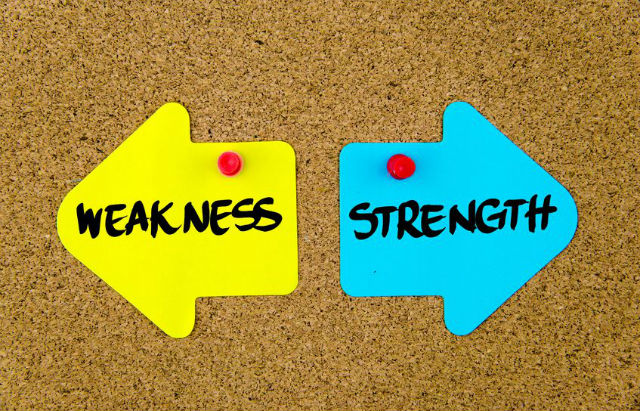How to Turn Strengths and Weaknesses into Profit


Turning Your Weaknesses into Strengths
Frequently one of the first parts of the poker coaching process involves the coach asking the student about their perceived strengths and weaknesses. There are two common trends in this area – number one, their perceptions in both categories tend to be guided by their own feelings or opinions rather than hard data, and number two, they tend to have a much clearer idea of the areas in which they aren’t very proficient, as opposed to the ones they are.
This is particularly unusual, given that you would expect players to have at least a somewhat developed idea of the things they already know, but it does seem to be a trend nevertheless. An almost inevitable consequence of this trend is that many players are left with weaknesses they know they need to work on, but without much of a plan for how to work on them (coaching notwithstanding). Let’s look at a few ways players can rectify that problem.
Understanding How and Why They Became Weaknesses
First and foremost, it’s important to recognize how a weakness came to be. If you know you don’t play well in three-bet pots, for example, you can start to analyze the strategic and psychological factors contributing to this problem. The reason I add psychological factors into the mix is because many people struggle with mental game issues above and beyond strategic concerns – for example, you might play poorly in three-bet pots because you’re scared to play big pots, either due to playing above your bankroll or confidence issues.
In addition, we have to look at the ‘why’ – why is a weakness a weakness? To use the same example, why is it a weakness to play poorly in three-bet pots? In this instance, it would be because three-bet pots are often bigger pots where our opponents’ ranges are stronger, and thus a mistake can often cost us more than it would in a single-raised pot. On the turn and river especially, three-bet pots can lead to huge situations with big EV rewards for making good decisions, and big EV punishments for making bad ones.
Developing a Strategy for Consistent Improvement
The next step is to outline a plan for how to get from where you are, to where you want to be. Hard data is particularly useful in this step – for example, if you figure out that your win rate (or rather, loss rate) when calling three-bets is -200 EVbb/100 hands in Holdem Manager 2 (not particularly uncommon, a lot of people struggle in three-bet pots), you might begin by setting a goal of reaching breakeven over your next 5,000 hands in these spots. Then, you might move on to aiming for +100EVbb/100, a solid positive win rate.
When it comes to actually improving on your strategic and psychological flaws causing the weakness in the first place, you need to tackle the problem on both fronts. You need to be doing intensive analysis of specific hands and situations in order to figure out the factors you may not yet be considering (ideally with the help of a coach), and you need to be digging deep into your own mental approach to figure out whether there’s anything interfering with your mindset. Be really honest with yourself – very frequently, leaks that appear to be strategic in nature are actually psychological. A reluctance to bluff the river, for example, is just as often a case of risk-aversion as a failure to understand an opponent’s tendencies.
Recognise the Same Weaknesses in Others
Finally, gaining a well-developed understanding of your own weaknesses in certain situations will eventually allow you to start identifying the same flaws in other players’ games. You’ll go from being someone who plays very tightly in three-bet pots (again, that’s just an example) and doesn’t put pressure on their opponents to someone who takes every edge they can find, and makes life extremely difficult for anyone who tries to cross them.
The key to this step is to be able to step outside your own game and analyze it from an external perspective. Figure out what your opponents should do, could do and probably are doing to exploit you, and recognize the appropriate response to that strategy. Once you know the exploits for your own weaknesses, you’ll not only be able to close up those weaknesses by anticipating the adaptations your opponents are going to make and the spots they’re going to put you in, but also by knowing exactly what to do every time you come up against an opponent with the same weakness.
The beauty of this part? Most weak players have the same weaknesses. Calling and folding when they should be betting and raising, or betting and raising when they should be calling and folding – eventually they’re just two sides of the same coin. With time and experience, you’ll learn to gauge the difference between manifestations of these weaknesses, but each weakness you spot in yourself is an opportunity to turn that weakness into a strength.




